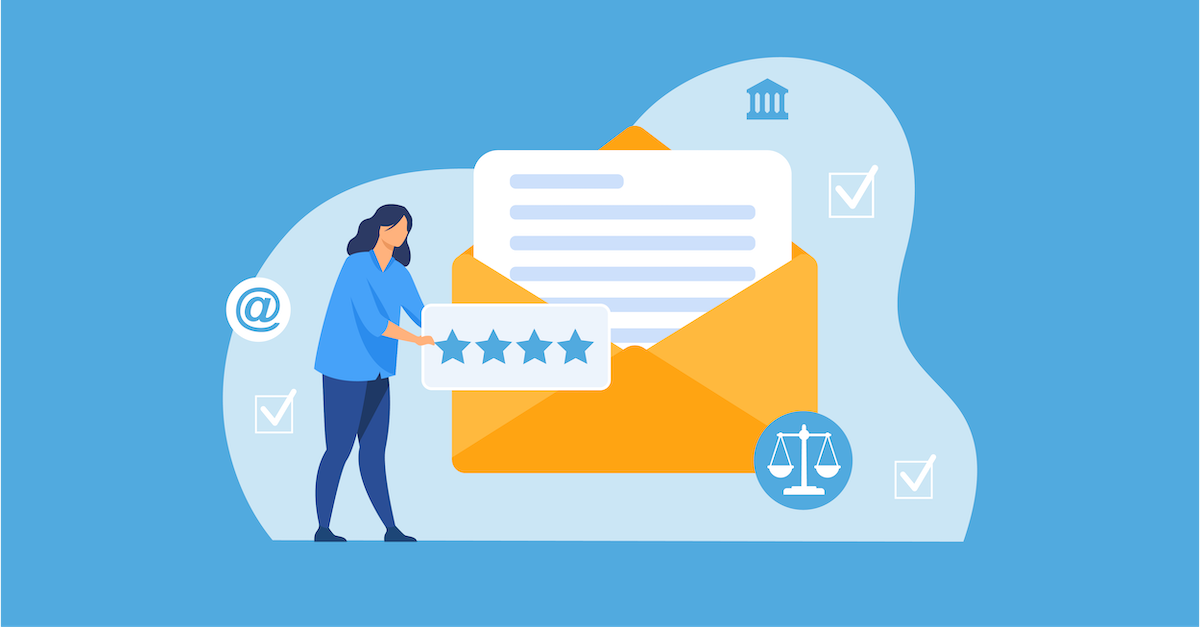Introduction
As a marketer, nothing is more important than having prospects see your amazing content. And out of all the email marketing metrics, email deliverability is arguably the most important one to monitor and measure.
Unfortunately, creating an email that looks great and has killer copy is just the first step in ensuring your message ends up in an inbox. When it comes to email marketing campaigns, there are several other factors to keep in mind to ensure that your email reaches its intended audience safely. These factors can be both visual and technical in nature, making it crucial to pay attention to all aspects of email development and launch.
Fortunately, there are many ways to improve your email deliverability rates, and this blog will cover several of them. We'll begin by explaining the fundamentals of email deliverability and then delve into best practices, technical factors that affect deliverability, and how testing and analytics can help. Whether you're new to email marketing or a seasoned pro, this guide will provide you with the information you need to succeed.
Understanding Email Deliverability
To understand how to increase email deliverability, it’s important to know the definition of email deliverability.
Email Deliverability Definition
Email deliverability refers to the ability of an email to arrive at its intended recipient's inbox successfully. In other words, it's the rate at which emails make it to the inbox instead of being blocked or filtered as spam by email service providers.
Email servers and spam filters use multiple data points to decide whether or not to let your emails through to their users. Following the best practices below will increase the chances of your marketing emails hitting an inbox and significantly improve the user experience.
Email Deliverability Best Practices
Many tips, tricks, and best practices exist to help increase email deliverability. Let’s get into a few of the most common ones you can implement.
Use a consistent "from" name and email address
When contacting customers via email, keeping a consistent name and email address can be essential to build trust with the recipient. For example, someone would likely expect the email address from TestCorp Customer Support to be “support@testcorp.com.” Keep the naming structure consistent and avoid changing names.
Create a compelling subject line
Did you know that 47% of all emails are opened solely based on the subject line alone? And 69% of recipients will report spam based on the subject line. That can impact email deliverability substantially.
Some tips for creating compelling subject lines include:
- Keep it concise - Good subject lines should be 6-8 words, to the point, and quickly capture the reader’s attention
- Use action-oriented language - When possible, use verbs or other action words in your subject line
- Make it specific - Be specific about what the email is about
- Use personalization - Research shows open rates can increase by 50% when the subject line is personalized to include the recipient’s name or other personal information
- Create a sense of urgency - Use words that create a sense of urgency for the reader to act quickly. According to research, urgent subject lines increased open rates by 22% (but, if you work in a highly-regulated industry, use caution when using this tactic to avoid potential UDAAP violations)
- Avoid spam trigger words - Avoid using words that might trigger the recipient’s spam folder. This could include words like “free,” “act now,” and “limited-time offer”
Write quality email content
Writing quality email content, in general, is always good advice when it comes to email marketing, but there are some things to keep in mind, specifically on the technical side.
From a technical standpoint, here are some best practices for producing quality email content:
- When including links in your email content, ensure they lead to safe and secure websites with good reputations
- Avoid backlinking to anything shady or spammy
- Always make sure your email source code is clean. If an email filter suspects anything in your email source code of being malicious, there’s a good chance your message will be blocked.
Avoid using too many images or large file attachments
Undoubtedly, email images can be helpful - nobody wants to stare at a wall of text in front of them! But there are best practices regarding including images within your message.
As a general rule of thumb, your email should be kept to a ratio of 80% text to 20% images. This will help avoid spam filter blockage due to being too picture-heavy and protect your email against being unreadable if the email client cannot load your pictures.
Email file attachments can be tricky. In some instances, they may be necessary. But when not needed, they should be avoided. File attachments are a commonly known way for hackers to infect victims with malware, and because of this, many people avoid clicking on them anyway.
There’s also a chance they may report your email for spam due to suspicion, or a spam filter may just block it.
If a file must be shared, use a cloud storage/file-sharing tool with a shared link in the body of the email instead of an attachment.
Include a clear call-to-action
Including a clear call-to-action will help lead to more click-throughs and conversions. This, in turn, helps with email performance, which could help with deliverability metrics in the future.
Call-to-action buttons should be simple, actionable, and prominent within the email. Make sure that it stands out against the rest of the email content and is easily visible and clickable by the prospect. Use language on your CTA that invites a click and doesn’t scare the reader away.
Use a reputable email service provider
Using a reputable email service provider might be one of the most significant factors affecting email deliverability. Internet service providers will often look at the sender reputation score of an email service provider when a message is sent.
If the provider has a low score, there is a good chance that emails coming from them may be blocked. Alternatively, a high score dramatically increases your email's likelihood of hitting the target inbox.
If you’re curious about your sender score, some tools allow you to check it on your own.
Make it easy for subscribers to unsubscribe
Creating an easy-to-use unsubscribe feature in your emails is essential for increasing email deliverability and engagement. It’s also a key measure in the CAN-SPAM Act.
Although the common thought around unsubscribes is that they’re something to avoid at all costs, a lot of good can come from them. When a person unsubscribes from your messaging, they likely didn’t have an interest in what you were offering, which, had they continued to receive your emails, likely would have brought down your metrics.
Instead of dreading them, think of unsubscribes as your contact list engaging in a self-cleansing!
Those who haven’t taken themselves off your mailing list should be more engaged and help with open and click-through scores, improving your sender reputation.
Monitor and maintain a clean email list
When sending out marketing emails, paying close attention to the prospects that occupy your lists is crucial. Email segmentation should always be observed and practiced.
This means taking your entire list of contacts and breaking it down into groups that are more likely to react positively to the email you are sending them. By doing this, you’re helping to ensure that metrics are increased and spam complaints are reduced.
When creating lists, it’s also important to consider other factors. If someone has opted out of email communications, ensure they are suppressed from future emails. If an email address has a hard bounce or multiple soft bounces, they should be removed. Having a high bounce rate can adversely affect your sender reputation.
Some email services can also remove “unengaged contacts” from your mailers, significantly improving open and click-through rates.
All these practices will help improve your metrics and deliverability rates.
Utilize a Mobile Friendly Format
Today, 81% of emails are opened and read on mobile devices. If you aren’t optimizing your messages to be read on mobile, you’re likely alienating many prospects.
Make sure your emails are easily read on mobile devices. An email that looks bad on someone’s phone will likely be ignored and may even be reported as spam.
Many services on the market allow you to see how your email will look on a mobile device and many other types of devices and email clients.
Technical Factors Affecting Deliverability
Aside from content, different technical factors can affect your email deliverability and sender reputation. We’ll dive into a few of them in this section.
The importance of DKIM, SPF, and DMARC
Although they look like random letters thrown together in an alphabet soup, DKIM, SPF, and DMARC are often regarded as the holy trinity of email authentication.
Why is email authentication important?
With phishing schemes being as prominent as ever, email authentication is essential to show that you are who you say you are and not some ne’er-do-well scammer. By using email authentication, you let spam filters know that you’re a legitimate sender, which can boost your sender reputation and make it less likely that your emails will be blocked.
So what are DKIM, SPF, and DMARC? Let’s quickly dive into what each means and how they work together.
What is DKIM (DomainKeys Identified Mail)?
DKIM (DomainKeys Identified Mail) is a method for email authentication that allows the receiver to check if an email message was sent by the domain owner it claims to come from and that the message was not altered during transmission. It involves adding a digital signature to the email header that can be verified using public key cryptography.
What is SPF (Sender Policy Framework)?
Not just a measure of protection on your sunscreen tube, SPF (Sender Policy Framework) is an email authentication method that allows email servers to verify whether incoming messages are sent from the domain they claim to come from. It specifies which servers are authorized to send emails for a particular domain, and other email servers can use this information to determine whether an incoming email is legitimate.
What is DMARC (Domain-Based Message Authentication, Reporting, & Conformance)?
DMARC (Domain-based Message Authentication, Reporting, and Conformance) is an email authentication protocol that builds upon SPF and DKIM to provide a comprehensive email authentication solution. Email senders can specify email handling policies if they fail authentication checks. It enables email receivers to report to senders about emails that fail authentication.
These protocols help prevent email phishing, spoofing, and other types of email fraud. By using some combination of these three tools, your organization can tell email providers and spam filters that you are legitimate.
To get help enabling email authentication or verifying that you have it, an excellent place to start would be to reach out to your technical support department or team.
The Roles of Testing and Analytics
Testing different components of your email campaigns before sending them out can be a critical step in the planning process. Here are some of the things you should look at and assess:
- Authentication - Were DKIM, SPF, and DMARC set up correctly? Make sure to engage in some authentication testing to ensure that these protocols have been implemented and are working correctly.
- Content Rendering - As mentioned earlier, always test how your email will render on different devices, browsers, and email clients. If your email is image-heavy, there’s a chance it may not look correct in specific inboxes, which is something you always want to avoid.
- A/B Testing - When setting up your email campaign, always keep A/B testing in mind. A/B testing different elements, like subject lines, button color, etc., will help you obtain valuable data that can be used in crafting future emails and a hedge against the chance one subject line is captured by a spam filter.
After sending the email, check the analytics. Metrics like deliverability rate, open rate, and click-through rate are how you will judge your campaign's success. Use these metrics to assist in building new campaigns. If something works well, use a similar strategy in the future.
If something is unsuccessful, it’s important to take note and try not to repeat the same process.
Conclusion
Monitoring and measuring email deliverability is crucial for email marketers. While creating visually appealing messages may improve engagement, other factors significantly influence campaign success.
To ensure optimal email deliverability, marketers should prioritize best practices, verify their emails' technical soundness regarding authentication, and continually test and analyze metrics. By adhering to these practices, email marketers can enhance the success of their efforts and maximize their emails' reach to as many inboxes as possible.
LashBack provides email auditing tools to help companies monitor their email content for compliance violations, content changes, and other potential issues that might affect email deliverability, allowing for quick remediation. LashBack BrandAlert also provides a tool to assess the overall performance of your campaigns - including inboxing percentages (what percentage of mail ended up in an actual inbox as opposed to a spam folder) and granular items such as subject line performance.
If your organization prioritizes and tracks email deliverability metrics, utilizes email marketing partners, or wants to keep a close eye on all email content with your brand attached, LashBack's tools may be helpful.
To learn more, you can request a demo here.


![Marketing Email Insights to Know from Q1 2024 [Data]](https://lashback.com/wp-content/uploads/2024/05/2024-05-data-insights-q1.png)

